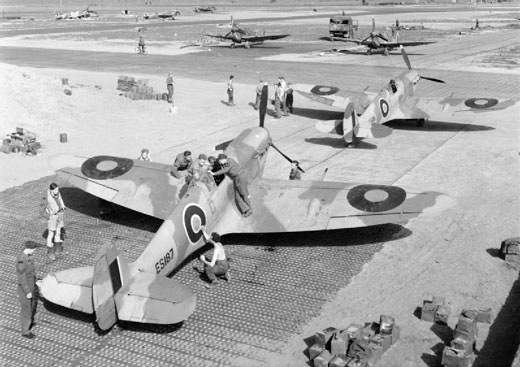Air Operations, Aleutians
6 28th Composite Bomb Group B-24s and 6 B-25s attack Kiska.
[Air Operations, CBI
BURMA- 341st Medium Bomb Group B-25s attack a rail junction at Thazi.
- 51st Fighter Group P-40s attack Nsopzup and knock out a bridge at Kazu.
- 6 11th Medium Bomb Squadron B-25s attack stores at Mangshih.
Air Operations, Europe
BOMBER COMMANDDaylight Ops:
- 10 Mosquitos hit targets in Holland without a loss.
- 427 aircraft are sent to St Nazaire, the second target on the list of French U-boat base ports after Lorient. Included in the total are 152 Lancasters, 119 Wellingtons, 100 Halifaxes and 62 Stirlings.
- This initial raid causes widespread destruction. It is reported that many of the bombs fall into the port area and about 60 percent of the town is destroyed. 29 people are killed and 12 are injured. It is presumed that most of the local population had already left the town.
- 2 Lancasters, 2 Wellingtons and 1 Stirling are lost.
- 3 Mosquitos are sent to the Ruhr, 5 Wellingtons lay mines off St Nazaire and there are 2 OTU sorties.
- There are no losses.
Damage in the Loire Shipyards |
 |
Royal Air Force Operations |
 |
Air Operations, New Guinea
1 43rd Heavy Bomb Group B-17 attacks the airfield at Lae.
[Air Operations, Solomons
- VB-101 PB4Ys and 347th Fighter Group P-38s attack the Vila airfield on Kolombangara.
- 307th Heavy Bomb Group B-24s attack the Kahili airfield on Bougainville and Ballale Island.
Burma
Completion of a new Burma Road allows Chinese forces in northern Burma to receive supplies by land rather than by laborious air drops and landings, the Japanese having originally cut the road in early 1942. The road runs 300 miles from Ledo to southern China, and was constructed by US Army engineers with more than 14,000 indigenous laborers.
[Air Operations, Tunisia
NATAF fighters and fighter-bombers attack German Army tanks, troops, and motor vehicles in the battle areas southwest of Mateur, at Sidi Nasr, near Bedja, and around Goubellat.
[CBI
Completion of a new Burma Road allows Chinese forces in northern Burma to receive supplies by land rather than by laborious air drops and landings, the Japanese having originally cut the road in early 1942.
Maj-Gen Lewis A. Peck, the chief engineer for the project. overcomes exceptionally difficult problems with terrain. The Ledo Road project is assisted by efforts of a civilian-military team from the Office of Strategic Services (OSS) known as Detachment 101. Under the command of Maj Carl Rifler, Detachment 101 conducts reconnaissance, trains native guerrillas, and rescues downed pilots. Stilwell orders an increase in the number guerrillas trained and ready for operations by the end of the year.
[Eastern Front
The struggle rages in the Orel-Bryansk area, and further south German armor re-takes Kramatorsk. The beginnings of the spring thaw hold up Russian operations against von Kleist's bridgehead in the Kuban and on the line of the Mius River north of Taganrog.
On the Soviet western front Timoshenko's armies are heavily engaged in the Demyansk sector.
NORTHERN SECTORThe last German units leave the Demyansk salient; it has cost the Soviet Northwestern Front 10,016 killed and 23,647 wounded to establish a line on the Lovat.
SOUTHERN SECTORThe Soviet 40th Army is across the Psel River but is unable to take Sumy due to enemy resistance. As the XLVIII Panzer Corps reaches the Donets west of Izyum, the Soviets retreat from Barvenkovo to Izyum to avoid being cut off.[MORE]
[Germany, Command
Gen Heinz Guderian is appointed Inspector-General of Armored Troops. He will be responsible directly to Hitler and with wide-ranging powers to re-equip, re-train, and re-vitalize the decimated Panzer force and 'make that arm of the Service into a decisive weapon for winning the war'.
[Mediterranean
The US freighter Daniel Carroll (7176t), in Convoy TE-16, is torpedoed by U-371 off the coast of Algeria. She is towed to Algiers by a British tug. She suffers no casualties.
[North Africa
TUNISIAGerman forces are contained. Their counteroffensive was costly to the inexperienced American troops of the II Corps who suffer about 6,500 casualties. Total Allied casualties in the Kasserine fighting were 10,000 to 2,000 for the Axis troops.
In the British 1st Army area, the V Corps continues to contain enemy attemps to advance on Bédja. In the US II Corps area, the enemy has now retired to Eastern Dorsal, abandoning Sbeïtla and Fériana. The II Corps patrols actively.
[Norway, Resistance
The Norsk Hydro power station near Ryukan is badly damaged by a sabotage team of 9 Norwegian soldiers led by Lt Haugen who have been parachuted in from Britain. They blow up 286 heavy water cells thereby depriving the Nazis of raw materials for atomic weapon research. Piping and tubes used in the production of 'heavy water' are also destroyed. This plant is known to be being used by the Germans to produce 'heavy water', vital in atomic research. Germany's heavy water program is delayed for only 4 months, however, as German and Norwegian engineers return the facility to full production in June. Haugen escapes to Sweden.
[